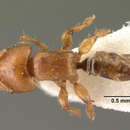en
names in breadcrumbs


Miles. Caput subquadratum, antice parum angustatum, mediocris magnitudinis; mandibulae crassae, margine externo subrecto, tridentatae, dente apicali magno, valde producto, acuminato; clypeus convexus, haud carinatus, antice medio subsinuatus; area frontalis nulla; laminae frontales breves, approximatae; linea frontalis abbreviata; oculi mediocres, depressi, prope mandibularum articulationes. Antennae breves, 6 - articulatae, clava bi-articulata, articulo flagelli 1. ° longitudine duorum sequentium, 2. ° 3. ° que subaequalibus, parvis, 4. ° longitudine primi sed multo crassiore, ultimo maximo, ovali, longitudine trium praecedentium. Thorax supra aequaliter arcuatus, sino ulto suturarum vestigio, postico sinuatus, inermis. Petioli segmentum primum triangulare, postice parum elevatum; secundum paullo latius, valde transversum, postice cum abdomine coalescens, ab eo vix distincte separatum. Pedes breves, crassi, tarsorum articulo primo permagno, valde incrassate, subquadrato, apice truncata vel sub-emarginato, levitcr compresso.
Operaria. Militi omnino similis, differt tantum capite (haud minore) antice vix angustato, postice minus evidenter sinuato, etmandibulis apice obtuse tridentatis, dente apicali haud producto.
Genere singolarissimo e ben distinto da tutte le formiche note finora, principalmente per la struttura dei suoi tarsi e delle sue antenne; quantunque il secondo segmento del picciuolo sia largamente saldato con 1 ' addome, pur nondimeno questa formica deve, per le sue analogie, riferirsi ai Mirmicidei; per la struttura del torace e delle antenne, rassomiglia un poco al genere Ooceraea , in vicinanza del quale dovra essere situata; e notevole il fatto della esistenza di due forme di neutri (soldato e operaria) diversi, non per statura o grandezza del capo, ma soltanto per la forma di questo e delle mandibole.
Melissotarsus is a rare African genus of ants in the subfamily Myrmicinae.[2] They are known from the Afrotropics and Malagasy regions, where their nests are located in living wood, built by tunneling through the wood under the bark. They are rarely seen outside of their nests, which may contribute to their perceived rarity.[3] However, they are considered pest insects because of damage they can cause to trees, including economically important ones such as mangos and trees in the family Burseraceae, including Aucoumea klaineana, Dacryodes buettneri, and Dacryodes edulis.[4]
Melissotarsus live in association with armored scale insects, family Diaspididae.[4][5] A study in Cameroon estimated that a single Dacryodes edulis tree hosted about 1.5 million Melissotarsus beccarii (larvae included) and half a million Diaspis armored scale insects; the densities were about 43 and 15 thousand M. beccarii and Diaspis per square metre bark, respectively.[4] The ants appear to consume the secretions used to manufacture armored scales because Diaspididae are completely naked when ant-attended; the ant nest itself remains completely hidden under the bark of the tree.[5][6]
Melissotarsus is a rare African genus of ants in the subfamily Myrmicinae. They are known from the Afrotropics and Malagasy regions, where their nests are located in living wood, built by tunneling through the wood under the bark. They are rarely seen outside of their nests, which may contribute to their perceived rarity. However, they are considered pest insects because of damage they can cause to trees, including economically important ones such as mangos and trees in the family Burseraceae, including Aucoumea klaineana, Dacryodes buettneri, and Dacryodes edulis.
Melissotarsus live in association with armored scale insects, family Diaspididae. A study in Cameroon estimated that a single Dacryodes edulis tree hosted about 1.5 million Melissotarsus beccarii (larvae included) and half a million Diaspis armored scale insects; the densities were about 43 and 15 thousand M. beccarii and Diaspis per square metre bark, respectively. The ants appear to consume the secretions used to manufacture armored scales because Diaspididae are completely naked when ant-attended; the ant nest itself remains completely hidden under the bark of the tree.